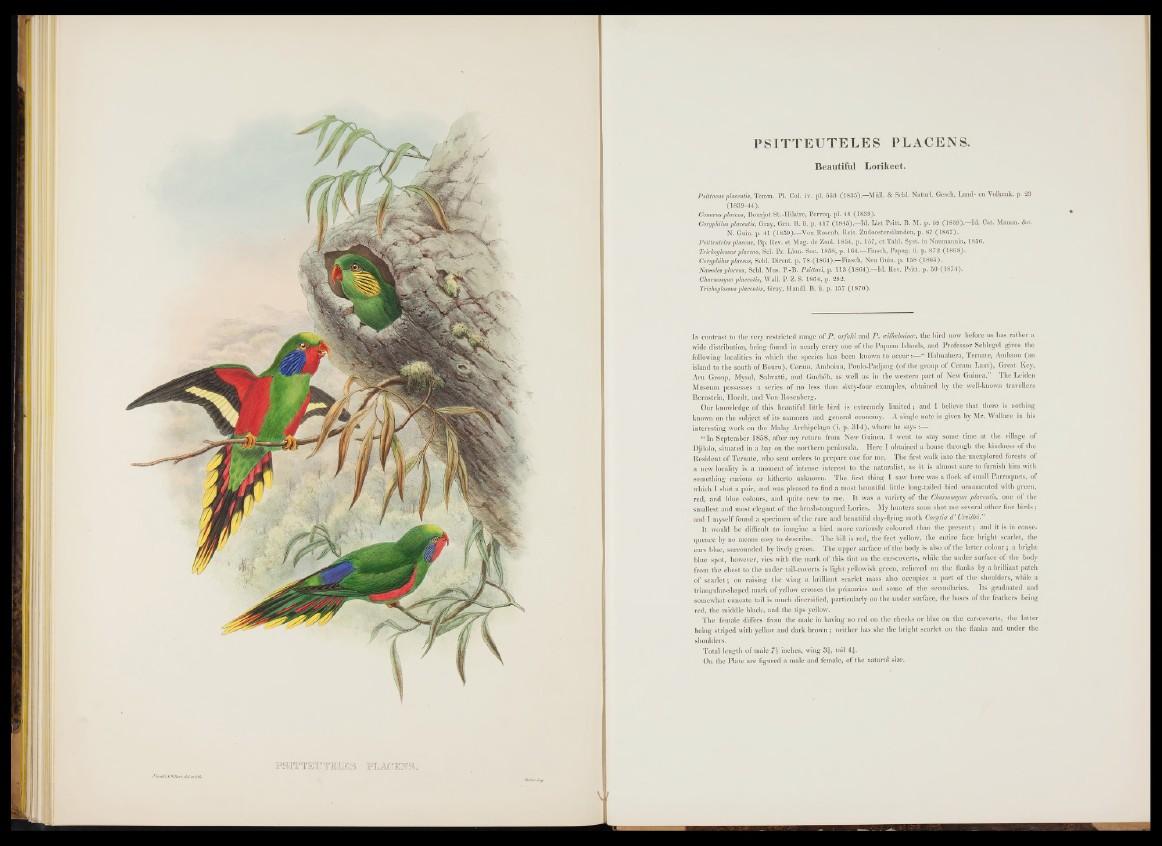
FSITTEIPTEILES ELACEWSV
PSITTEUTELES PLACENS.
Beautiful Lorikeet.
Psittacus placentis, Temm. PI. Col. iv. pi. 553 (1835).—Mull. & Schl. Naturl. Gesch. Land- en Volkenk. p. 23
(1839-44).
Conwrus placens, Bourjot St.-Hilaire, Perroq. pi. 46 (1839).
Coryphihsplacentis, Gray, Gen. B. ii. p. 417 (1845).—Id. List Psitt. B. M. p. 59 (1859).—Id. Cat. Mamm. See.
N. Guin. p. 41 (1859).—Von Rosenb. Reis. Zudoostereilanden, p. 87 (1867).
Psitteuteles placens, Bp. Rev. et Mag. de Zool. 1854, p. 157, et Tabl. Syst. in Naumannia, 1856.
Trichoglossus placens, Scl. Pr. Linn. Soc. 1858, p. 164.—Finsch, Papag. ii. p. 872 (1868).
Coryphilus placens, Schl. Dirent. p. 78 (1864).—Finsch, Neu Guin. p. 158 (1865).
Nanodes placens, Schl. Mus. P.-B. Psittaci, p. 113 (1864).—Id. Rev. Psitt. p. 50 (1874).
Gharmosyna placentis, Wall. P. Z. S. 1864, p. 292.
Trichoglossus placentis, Gray, Handl. B. ii. p. 157 (1870).
In contrast to the very restricted range o f P . arfaki and P. wilhelminee, the bird now before us has rather a
wide distribution, being found in nearly every one o f the Papuan Islands, and Professor Schlegel gives the
following localities in which the species has been known to o c c u r:—“ Halmahera, Ternate, Ambaou (an
island to the south o f Bouru), Ceram, Amboina, Poulo-Padjang (o f the group o f Ceram Laut), Great Key,
Aru Group, Mysol, Salwatti, and Guebeh, as well as in the western p a rt of New Guinea.” T h e Leiden
Museum possesses a series o f no less than sixty-four examples, obtained by the well-known travellers
Bernstein, Hoedt, and Von Rosenberg.
Our knowledge o f this beautiful little bird is extremely lim ite d ; and I believe th at there is nothing
known on the subject o f its manners and general economy. A single note is given by Mr. Wallace in his
interesting work on the Malay Archipelago (i. p. 3 1 4 ), where he says :—
“ In September 1858, after my return from New Guinea, I went to stay some time at the village of
Djilolo, situated in a bay on the northern peninsula. Here I obtained a house through the kindness o f the
Resident o f Ternate, who sent orders to prepare one for me. The first walk into the unexplored forests of
a new locality is a moment o f intense interest to the naturalist, as it is almost sure to furnish him with
something curious o r hitherto unknown. The first thing I saw here was a flock o f small Parroquets, of
which I shot a pair, and was pleased to find a most beautiful little long-tailed bird ornamented with green,
red, and blue colours, and quite new to me. I t was a variety o f the Charmosyna placentis, one o f the
smallest and most elegant o f the brush-tongued Lories. My hunters soon shot me several o ther fine b ird s ;
and I myself found a specimen o f the rare and beautiful day-flying moth Cocytia d Urvillei.
I t would be difficult to imagine a bird more variously coloured than the p r e s e n t; and it is in consequence
by no means easy to describe. The bill is red, the feet yellow, the entire face bright scarlet, the
ears blue, surrounded by lively green. The upper surface o f the body is also o f the latter colour ; a bright
blue spot, however, vies with the mark o f this tint on the ear-coverts, while the under surface o f the body
from the chest to the under tail-coverts is light yellowish green, relieved on the flanks by a brilliant patch
o f s c a r le t; on raising the wing a brilliant scarlet mass also occupies a p a rt o f the shoulders, while a
triangular-shaped mark of yellow crosses the primaries and some o f the secondaries. Its graduated and
somewhat cuneate tail is much diversified, particularly on the under surface, the bases o f the feathers being
red, the middle black, and the tips yellow.
T h e female differs from the male in having no red on the cheeks o r blue on the ear-coverts, the latter
being striped with yellow and dark brown ; neither has she the bright scarlet on the flanks and under the
shoulders.
Total length of male 7 i inches, wing 3 f, tail 4 i.
On the Plate are figured a male and female, o f the natural size.